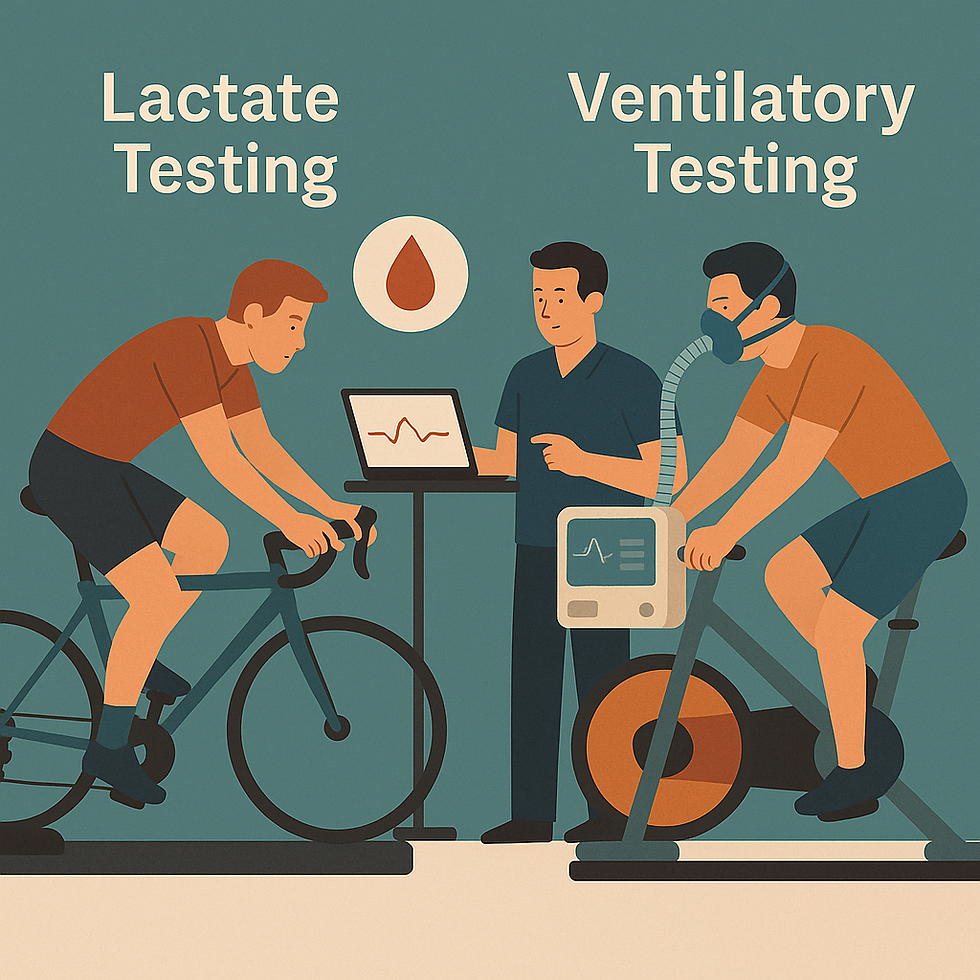Why are breath tests more reproducible than lactate tests?
- PAIRFS

- 3 days ago
- 3 min read
In performance analysis, two main approaches exist to determine physiological zones:
1️⃣ blood lactate measurement,
2️⃣ ventilatory analysis, via the VT1 and VT2 thresholds.
Both can be useful. But when we talk about reproducibility — that is, the ability of a test to produce the same result under the same conditions — scientific research is unequivocal:
👉 Breath tests are significantly more reliable than lactate tests .
Here's why.
1. Lactate is extremely sensitive to external conditions
Blood lactate levels vary greatly depending on:
the meal eaten before the test,
caffeine ,
the weather ,
hydration ,
the quality of the capillary drop ,
stress or lack of sleep,
the type of warm-up ,
the duration of the test stages .
Two tests performed 48 hours apart can give completely different lactate thresholds, even in a well-trained athlete.
➡️ Result: the variability of lactate tests is high.
2. Respiration directly reflects internal physiology
The ventilatory thresholds (VT1 and VT2) are based on the analysis of:
minute ventilation ,
of respiratory rate ,
of CO₂ dynamics ,
of ventilatory compensation .
These mechanisms are automatically regulated by the brain and respond directly:
to the production of CO₂,
to acidosis,
to meet immediate metabolic needs.
Unlike lactate, they do not depend on:
of the meal,
of the sampling technique,
hydration,
of the temperature.
👉 Result: ventilatory thresholds are stable , even when external conditions vary.
3. Research shows a very high reproducibility of ventilatory thresholds.
In studies conducted on runners and cyclists:
VT1 and VT2 show intra-athlete correlation coefficients between 0.90 and 0.98.
The power output at VT2 varies very little from one test to another.
The reproducibility far exceeds that of lactate or even VO₂max.
Lactate, on the other hand, shows:
a much higher inter-test variability,
a threshold sometimes shifted by 10 to 20% between two measurements.
4. Even in the laboratory, lactate tests can be inconsistent.
Common sources of error:
contamination of gout by sweat,
poor analyzer calibration
sampling too early or too late in the plateau
differences between fingers
lactate that “takes time to rise” → false reading.
Even specialists can obtain: → different thresholds depending on the method used (lactate steady state, 4 mmol, Dmax…).
👉 This is a test that requires a high level of expertise, which increases variability.
5. Breath tests detect real physiological transitions
Lactate = indirect measure of a phenomenon (acidosis).
Respiration = direct measurement of the physiological response to this acidosis.
VT1 → first increase in ventilation
VT2 → ventilatory compensation point
These transitions are visible, stable and reproducible .
With a sensor like ZoneX , they become:
measurable outdoors,
automatically detected
comparable from one session to the next,
without sampling or masks.
👉 This is no longer an occasional test: it is continuous monitoring.
6. Why this changes everything for training
Thanks to superior reproducibility:
You can track your progress more precisely.
to detect days of fatigue or overload,
adjust your zones automatically.
compare your sessions over weeks or months.
This is the basis of modern, personalized and reliable training.
Scientific references
Pallarés JG et al. (2016). Validity and Reliability of Ventilatory and Blood Lactate Thresholds in Well-Trained Cyclists. PLoS ONE. https://journals.plos.org/plosone/article?id=10.1371/journal.pone.0163389
Cerezuela-Espejo V. et al. (2018). The Relationship Between Lactate and Ventilatory Thresholds in Runners. Front Physiol. https://www.frontiersin.org/articles/10.3389/fphys.2018.01320/full
Weston S., Gabbett T. (2001). Reproducibility of Ventilation Thresholds in Trained Cyclists. Int J Sports Med. https://pubmed.ncbi.nlm.nih.gov/11702922/
Gaskill SE et al. (2001). Validity and reliability of combining three methods to determine ventilatory threshold. MSSE. https://pubmed.ncbi.nlm.nih.gov/11689733/
Amann M. (2012). Pulmonary system limitations to endurance performance. J Appl Physiol. https://pubmed.ncbi.nlm.nih.gov/22125308/
Poole DC, Jones AM (2021). Oxygen Uptake Kinetics and Limitations to VO₂max. Compr Physiol. https://doi.org/10.1002/cphy.c200006




Comments